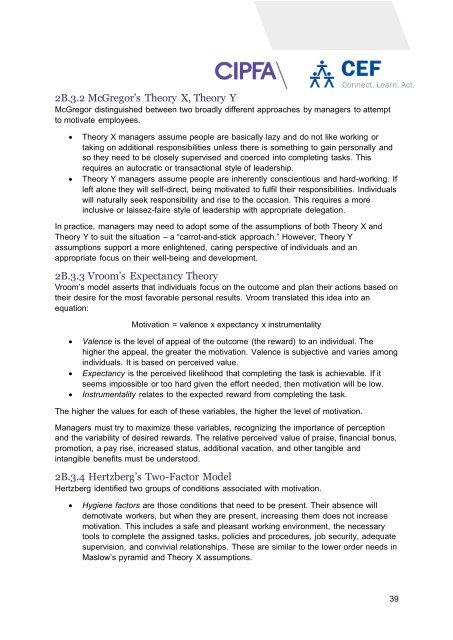TIAPS ALB_Module 2B. Managing People
- No tags were found...
Create successful ePaper yourself
Turn your PDF publications into a flip-book with our unique Google optimized e-Paper software.
<strong>2B</strong>.3.2 McGregor’s Theory X, Theory Y<br />
McGregor distinguished between two broadly different approaches by managers to attempt<br />
to motivate employees.<br />
• Theory X managers assume people are basically lazy and do not like working or<br />
taking on additional responsibilities unless there is something to gain personally and<br />
so they need to be closely supervised and coerced into completing tasks. This<br />
requires an autocratic or transactional style of leadership.<br />
• Theory Y managers assume people are inherently conscientious and hard-working. If<br />
left alone they will self-direct, being motivated to fulfil their responsibilities. Individuals<br />
will naturally seek responsibility and rise to the occasion. This requires a more<br />
inclusive or laissez-faire style of leadership with appropriate delegation.<br />
In practice, managers may need to adopt some of the assumptions of both Theory X and<br />
Theory Y to suit the situation – a “carrot-and-stick approach.” However, Theory Y<br />
assumptions support a more enlightened, caring perspective of individuals and an<br />
appropriate focus on their well-being and development.<br />
<strong>2B</strong>.3.3 Vroom’s Expectancy Theory<br />
Vroom’s model asserts that individuals focus on the outcome and plan their actions based on<br />
their desire for the most favorable personal results. Vroom translated this idea into an<br />
equation:<br />
Motivation = valence x expectancy x instrumentality<br />
• Valence is the level of appeal of the outcome (the reward) to an individual. The<br />
higher the appeal, the greater the motivation. Valence is subjective and varies among<br />
individuals. It is based on perceived value.<br />
• Expectancy is the perceived likelihood that completing the task is achievable. If it<br />
seems impossible or too hard given the effort needed, then motivation will be low.<br />
• Instrumentality relates to the expected reward from completing the task.<br />
The higher the values for each of these variables, the higher the level of motivation.<br />
Managers must try to maximize these variables, recognizing the importance of perception<br />
and the variability of desired rewards. The relative perceived value of praise, financial bonus,<br />
promotion, a pay rise, increased status, additional vacation, and other tangible and<br />
intangible benefits must be understood.<br />
<strong>2B</strong>.3.4 Hertzberg’s Two-Factor Model<br />
Hertzberg identified two groups of conditions associated with motivation.<br />
• Hygiene factors are those conditions that need to be present. Their absence will<br />
demotivate workers, but when they are present, increasing them does not increase<br />
motivation. This includes a safe and pleasant working environment, the necessary<br />
tools to complete the assigned tasks, policies and procedures, job security, adequate<br />
supervision, and convivial relationships. These are similar to the lower order needs in<br />
Maslow’s pyramid and Theory X assumptions.<br />
39
















